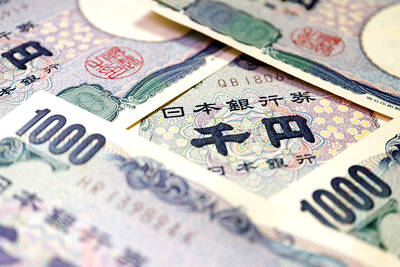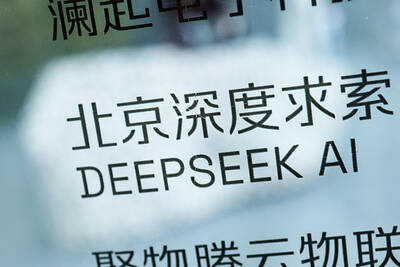Federal Reserve Bank of St Louis President James Bullard defended US Federal Reserve Chair Janet Yellen’s comments on interest-rate increases, saying her outlook is in line with private surveys on when the central bank might start tightening policy.
US Treasury bond yields jumped on Wednesday after Yellen said in her first press conference as Fed chair that rates could rise “around six months” after asset purchases end, most likely in the fall.
Bullard, speaking in Washington on Friday, said “the surveys that I had seen from the private sector had that kind of number penciled in, as far as I knew.”
“That wasn’t very different from what we had heard from financial markets, so I think she’s just repeating that at that time period,” Bullard said at a roundtable at the Brookings Institution.
Bullard does not vote on policy this year.
Bullard’s comments suggest “he might be pushing back” to counter the view in the markets that the Fed might raise interest rates sooner than expected, New York-based Societe Generale SA chief US economist Aneta Markowska said.
“They didn’t intend to change anything in terms of the market’s timing of the liftoff,” she said. “That wasn’t their intent and I think that’s what he’s trying to get across. The intention was just to reaffirm what they believed the market expectation was at the time.”
The Fed this week announced its third-straight US$10 billion reduction in the monthly pace of asset purchases, to US$55 billion.
Dallas Fed President Richard Fisher, who is a voting member of the policy-setting US Federal Open Market Committee (FOMC), said in a speech in London that the timetable makes it “pretty clear by October, if we continue at this pace, that our large-scale asset purchases will be terminated.”
He said market reaction to the policy outlined this week suggests some found it “disagreeable even if it is sound.”
The FOMC this week said it will look at a “wide range of information” in deciding when to raise its benchmark interest rate, dropping guidance tying borrowing costs to a 6.5 percent unemployment rate. The central bank also released new economic projections, which showed that officials expected higher interest rates by the end of next year and 2016 compared with estimates released in December last year.
Fisher suggested investors were placing too much emphasis on the change in forecasts, which the Fed illustrates as dots plotted on a chart.
There is a “fixation, if not a fetish, on the dots,” he said at the London School of Economics.
The change in forecasts by Fed officials came before this week’s meeting, he said.
“Somehow, this was read as a massive shift,” Fisher said. “These are our best guesses.”
Fisher also said the Fed may consider boosting the interest it pays on excess bank reserves to control short-term interest rates after it winds down asset purchases.
“It is a tool we can use particularly in the exit side once we start, which I believe is quite out there in the future, moving the short-term base rate,” he said. “I am not going to put a time frame on it because it will be quite some time after we stop” large-scale asset purchases.
Minneapolis Fed President Narayana Kocherlakota was the only policymaker to dissent from Wednesday’s statement.
Kocherlakota on Friday said that the omission of quantitative benchmarks for policy fosters uncertainty and undercuts the Fed’s commitment to bring inflation back toward its 2 percent target.
An index of inflation watched by the Fed rose 1.2 percent from a year earlier in January and has not exceeded 2 percent since March 2012.

GROWING OWINGS: While Luxembourg and China swapped the top three spots, the US continued to be the largest exposure for Taiwan for the 41st consecutive quarter The US remained the largest debtor nation to Taiwan’s banking sector for the 41st consecutive quarter at the end of September, after local banks’ exposure to the US market rose more than 2 percent from three months earlier, the central bank said. Exposure to the US increased to US$198.896 billion, up US$4.026 billion, or 2.07 percent, from US$194.87 billion in the previous quarter, data released by the central bank showed on Friday. Of the increase, about US$1.4 billion came from banks’ investments in securitized products and interbank loans in the US, while another US$2.6 billion stemmed from trust assets, including mutual funds,

AI TALENT: No financial details were released about the deal, in which top Groq executives, including its CEO, would join Nvidia to help advance the technology Nvidia Corp has agreed to a licensing deal with artificial intelligence (AI) start-up Groq, furthering its investments in companies connected to the AI boom and gaining the right to add a new type of technology to its products. The world’s largest publicly traded company has paid for the right to use Groq’s technology and is to integrate its chip design into future products. Some of the start-up’s executives are leaving to join Nvidia to help with that effort, the companies said. Groq would continue as an independent company with a new chief executive, it said on Wednesday in a post on its Web

RESPONSE: The Japanese Ministry of Finance might have to intervene in the currency markets should the yen keep weakening toward the 160 level against the US dollar Japan’s chief currency official yesterday sent a warning on recent foreign exchange moves, after the yen weakened against the US dollar following Friday last week’s Bank of Japan (BOJ) decision. “We’re seeing one-directional, sudden moves especially after last week’s monetary policy meeting, so I’m deeply concerned,” Japanese Vice Finance Minister for International Affairs Atsushi Mimura told reporters. “We’d like to take appropriate responses against excessive moves.” The central bank on Friday raised its benchmark interest rate to the highest in 30 years, but Bank of Japan Governor Kazuo Ueda chose to keep his options open rather than bolster the yen,

Even as the US is embarked on a bitter rivalry with China over the deployment of artificial intelligence (AI), Chinese technology is quietly making inroads into the US market. Despite considerable geopolitical tensions, Chinese open-source AI models are winning over a growing number of programmers and companies in the US. These are different from the closed generative AI models that have become household names — ChatGPT-maker OpenAI or Google’s Gemini — whose inner workings are fiercely protected. In contrast, “open” models offered by many Chinese rivals, from Alibaba (阿里巴巴) to DeepSeek (深度求索), allow programmers to customize parts of the software to suit their